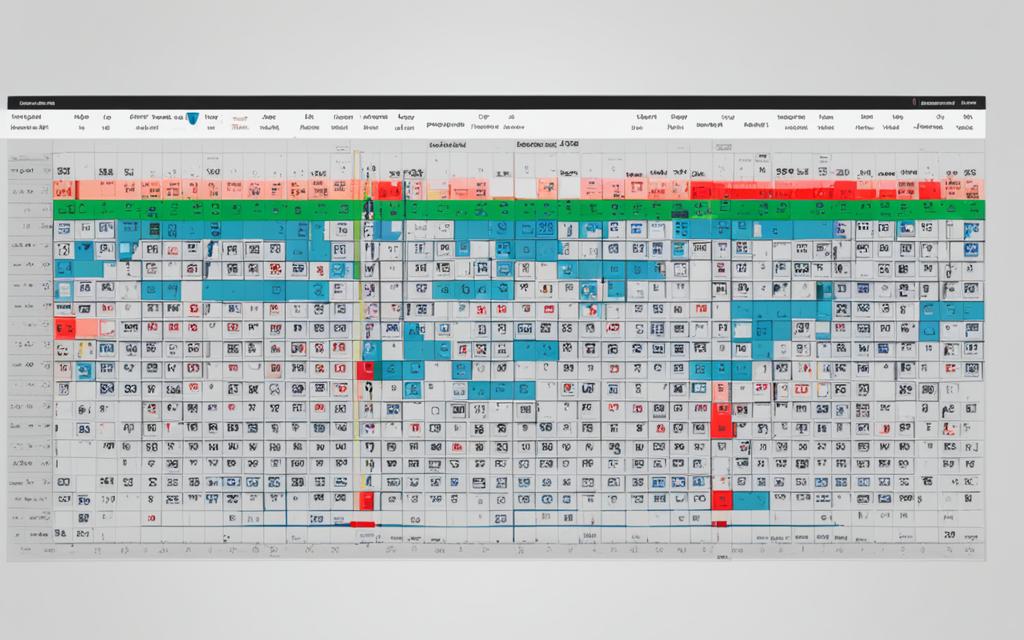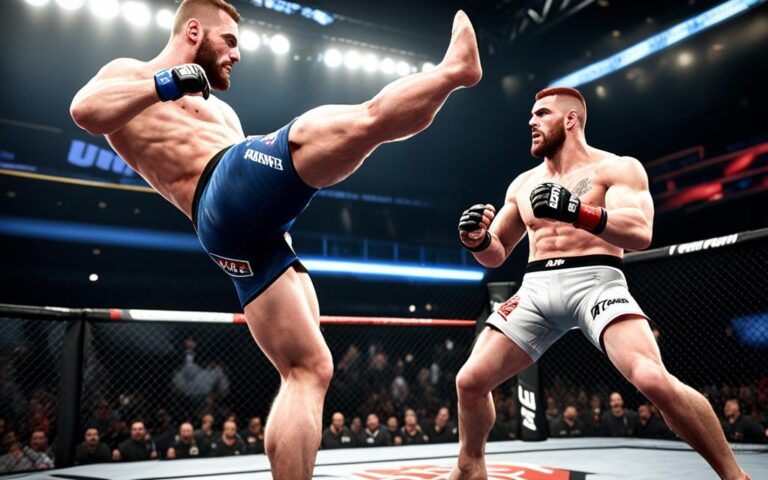Want to get ahead in UFC 4? It’s key to explore frame data analysis. By digging into past UFC fights, we learn about the best timings and strategies. This approach helps in spotting patterns and trends, making it easier to predict outcomes and enhance performance.
Understanding the Data: Winner and Loser Match-Ups
Studying historical data is key to finding crucial insights in UFC 4. We got data from the UFC stat website, looking at fights from 2010 to 2021. This deep dive gave us a lot of info on each fight, covering the winners, losers, fight conditions, and more.
When we looked closely, we saw that the fighter in the red corner mostly won. They are usually seen as the favourite. But, our study went further than just this finding. It also showed other things that might affect who wins.
- Win streaks: Longer winning runs upped a fighter’s chances of winning again.
- Total losses: Fewer past losses seemed to help fighters do better in fights.
- Age: Older fighters tended to do better.
- Reach: Having a longer arm span could give fighters a strategic edge.
- Significant strikes: How well a fighter landed big strikes often decided if they won.
- Takedowns: Good takedown skills often meant a fighter could win more.
By digging into these details, we hope to spot trends that can help us predict fight outcomes. This approach could make our fight forecasts more accurate. It’s all about using the data to make smarter predictions.
The Correlation Between Significant Strikes and Fight Outcomes
A key link in our data was between landing significant strikes and winning. Hitting your opponent hard and accurately can sway the judges in your favour. These strong hits can be crucial in winning rounds and, in the end, fights. The data showed that fighters who landed big strikes often won.
“The ability to land significant strikes provides a fighter with a considerable advantage in winning rounds and securing victory.”
This discovery underlines how crucial striking sharply is. Knowing this, future fighters can focus on their striking to up their chances in UFC 4.
Visual Representation of Fight Outcomes
We’ve made a table to clearly show how certain factors link to fight outcomes:
| Variable | Correlation with Fight Outcome |
|---|---|
| Win Streaks | Positive correlation |
| Total Losses | Negative correlation |
| Age | Positive correlation |
| Reach | Positive correlation |
| Significant Strikes | Positive correlation |
| Takedowns | Positive correlation |
This table can help fighters and fans understand what really affects fight outcomes. With this insight, they can plan better for their UFC 4 matches.
Now that we’ve looked at the data closely, we have a ground to create prediction models. These models could be a game-changer in how we guess UFC fight winners accurately. In the next part, we’ll see how we can use data to make these powerful models, thanks to machine learning.
The Power of Data: Building Predictive Models
We’re using data to predict fight outcomes in UFC 4. We’ve used five main machine learning algorithms. These include K-Nearest Neighbors, Logistic Regression, and others.
Our first task was to check how well these models work. We tested them using lots of UFC data. This data had info on fighters, fight conditions, and previous fight outcomes.
The logistic regression models turned out to be the best. They were really good at predicting who would win a fight. They looked at things like win streaks, age, and how good fighters were at striking.
But, these models aren’t always right. There are many things that can change the outcome of a fight. Things like new tactics, changes in training, and how much the fighters want to win matter a lot.
“It’s key to use predictive models along with other knowledge. This ensures your fight predictions are solid.”
We mix data analysis with intuition to help UFC fans and fighters. This approach helps us understand the sport better. It also guides how fighters train and what fans can expect in fights.
Conclusion
Data analysis is changing the game in UFC 4. It helps predict fight outcomes and boost performance. This is done by deeply exploring frame data and past records. This shines a light on crucial insights, giving an edge both to fighters and their fans.
Using advanced models like Logistic Regression and Decision Trees reveals useful patterns. These make our fight predictions more accurate. Yet, it’s key to not rely solely on these models. Success in the UFC comes from a mix of talent, hard work, and clever strategies.
When fighters combine data-driven insights with their experience, they step up their game. It helps them understand the sport better and make smarter moves in the octagon. Similarly, fans can enjoy UFC 4 more by knowing the details behind the matches.
FAQ
What is frame data analysis in UFC 4?
Frame data analysis in UFC 4 is about studying when and how fighters make their moves. This uses data from their past fights. It helps us understand how they act and win in the octagon.
Where does the data for frame data analysis come from?
Data for this analysis comes from the UFC stat website. It covers fights from 2010 to 2021. Each fight gives us info on the winner, fight details, striking accuracy, and more.
Are there any correlations between variables and fight outcomes?
Yes, many things link to who wins a fight. Things like win streaks, total losses, age, and reach show a match’s likely winner. Knowing these can help predict the fight’s outcome.
Which machine learning algorithms were used for predictive modeling?
Five algorithms were used for predicting fights: K-Nearest Neighbors, Logistic Regression, Decision Trees, Random Forest, and Extreme Gradient Boost. Logistic Regression algorithms were most accurate in their predictions.
Can these predictive models accurately forecast fight outcomes?
The models are very good, but they’re not perfect. They don’t take into account everything that can affect a fight. Fighters’ skills and strategies are also very important. So, use these models with caution when guessing the fight’s outcome.
How can frame data analysis help improve performance in UFC 4?
Analysing frame data can help fighters see hidden patterns. This knowledge can make their guesses about a match more accurate. Yet, practical skills and experience are also key to winning in the octagon.


















